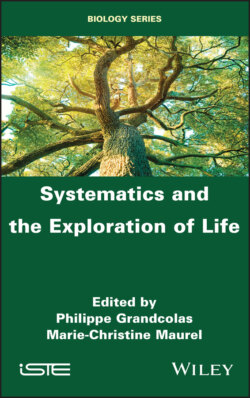Читать книгу Systematics and the Exploration of Life - Группа авторов - Страница 15
1.3. Isometries and symmetry groups
ОглавлениеIn this section, we propose an overview of the mathematical characterization of the notion of symmetry, as it can be applied to organic forms. The physical environment in which living organisms evolve is comparable to a three-dimensional Euclidean space. It is denoted by E3. A geometric figure is said to be symmetric if there are one or more transformations which, when applied to the figure, leave it unchanged. Symmetry is thus a property of invariance to certain types of transformations. These transformations are called isometries.
Formally, an isometry of the Euclidean space E3 is a transformation T: E3 → E3 that preserves the Euclidean metric, that is, a transformation that preserves lengths (Coxeter 1969; Rees 2000):
for all x and y points belonging to E3.
The different isometries of E3 are obtained by combining rotation and translation (x ↦ α Rx + t, where R is an orthogonal matrix of order 3 and t is a vector of ). They include the identity, translations, rotations around an axis, screw rotations (rotation around an axis + translation along the same axis), reflections with respect to a plane, glide reflections (reflection with respect to a plane + translation parallel to the same plane) and rotatory reflections (rotation around an axis + reflection with respect to a plane perpendicular to the axis of rotation). The set of isometries for which an object is invariant constitutes the symmetry group of the object.
For biologists wishing to explore symmetry in an organism, the correct identification of the symmetry group is important because it conditions the relevance of the morphometric analysis to come. The symmetry group of the organic form is always a subgroup of the isometries of E3. In particular, the translation has no exact equivalent in biology, since the physical extension of an organism is finite (the finite repetition of arthropod segments, for example). Translational symmetry is therefore approximate. The other isometries form a finite subgroup of Euclidean isometries, including the cyclic and dihedral groups, as well as the tetrahedral, octahedral and icosahedral groups of the Platonic solids that were dear to Thompson (1942, Chapter 9). It appears that, essentially, the symmetry patterns of biological shapes correspond to cyclic groups (rotational symmetry of order n alone [Cn], or combined with a plane of symmetry perpendicular to the axis of rotation [Cnh], or with n planes of symmetry passing through the axis of rotation [Cnv]). The bilateral symmetry of bilaterians corresponds, for example, to the group C1v, in other words, a rotation of 2π/1 (identity) combined with a reflection across a plane passing through the rotation axis.
